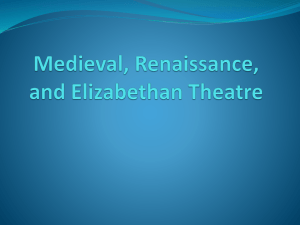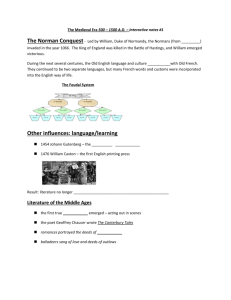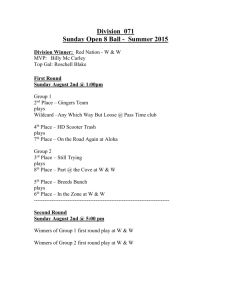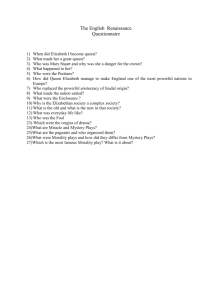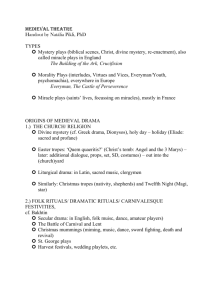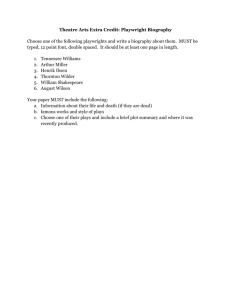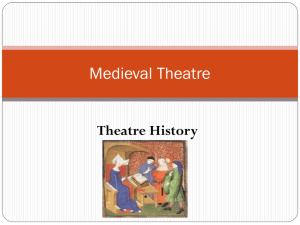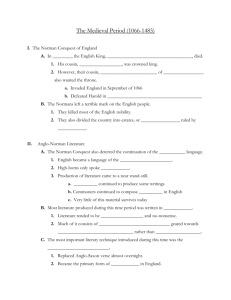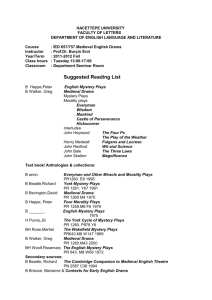MEDIEVAL DRAMA AND THEATRE
advertisement
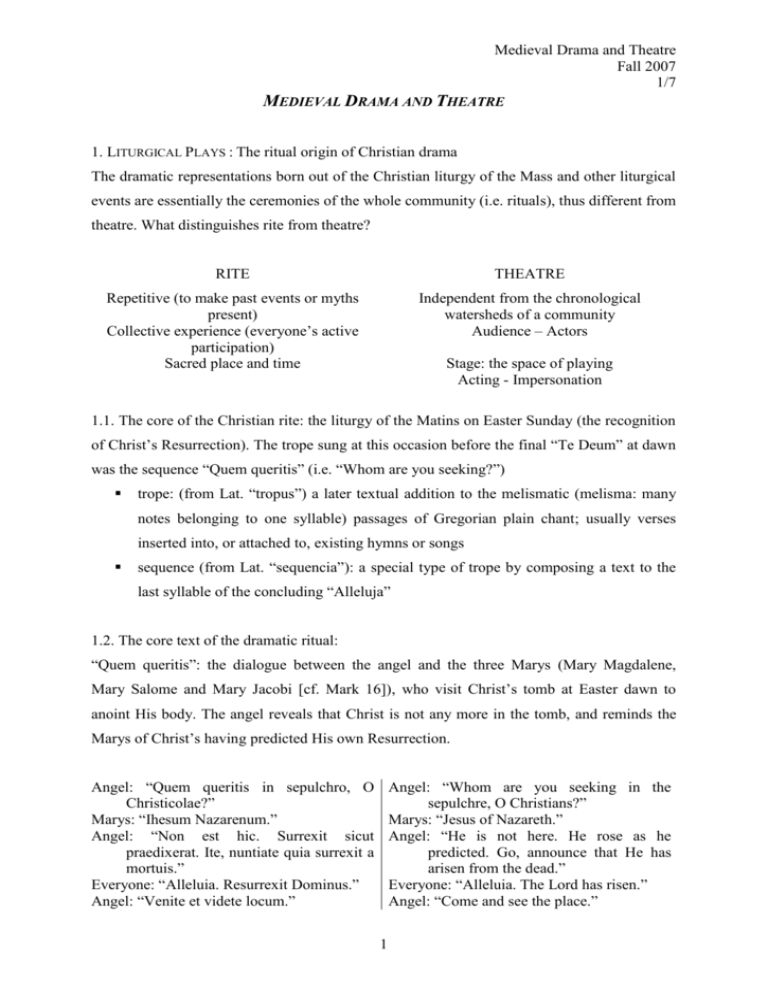
Medieval Drama and Theatre Fall 2007 1/7 MEDIEVAL DRAMA AND THEATRE 1. LITURGICAL PLAYS : The ritual origin of Christian drama The dramatic representations born out of the Christian liturgy of the Mass and other liturgical events are essentially the ceremonies of the whole community (i.e. rituals), thus different from theatre. What distinguishes rite from theatre? RITE THEATRE Repetitive (to make past events or myths present) Collective experience (everyone’s active participation) Sacred place and time Independent from the chronological watersheds of a community Audience – Actors Stage: the space of playing Acting - Impersonation 1.1. The core of the Christian rite: the liturgy of the Matins on Easter Sunday (the recognition of Christ’s Resurrection). The trope sung at this occasion before the final “Te Deum” at dawn was the sequence “Quem queritis” (i.e. “Whom are you seeking?”) trope: (from Lat. “tropus”) a later textual addition to the melismatic (melisma: many notes belonging to one syllable) passages of Gregorian plain chant; usually verses inserted into, or attached to, existing hymns or songs sequence (from Lat. “sequencia”): a special type of trope by composing a text to the last syllable of the concluding “Alleluja” 1.2. The core text of the dramatic ritual: “Quem queritis”: the dialogue between the angel and the three Marys (Mary Magdalene, Mary Salome and Mary Jacobi [cf. Mark 16]), who visit Christ’s tomb at Easter dawn to anoint His body. The angel reveals that Christ is not any more in the tomb, and reminds the Marys of Christ’s having predicted His own Resurrection. Angel: “Quem queritis in sepulchro, O Christicolae?” Marys: “Ihesum Nazarenum.” Angel: “Non est hic. Surrexit sicut praedixerat. Ite, nuntiate quia surrexit a mortuis.” Everyone: “Alleluia. Resurrexit Dominus.” Angel: “Venite et videte locum.” Angel: “Whom are you seeking in the sepulchre, O Christians?” Marys: “Jesus of Nazareth.” Angel: “He is not here. He rose as he predicted. Go, announce that He has arisen from the dead.” Everyone: “Alleluia. The Lord has risen.” Angel: “Come and see the place.” 1 Medieval Drama and Theatre Fall 2007 2/7 Marys: “The Lord has risen from the tomb.” Everyone: “We praise You, God.” Marys: “Surrexit Dominus de sepulchro.” Everyone: “Te Deum laudamus.” The earliest extant document in England, containing the text and the description of the liturgical play at Easter Matins, survived in the 10th-century Regularis Concordia (a document witnessing the 10th-century monastic reforms and the endeavour to unify the liturgical practices in English Benedictine monasteries). 2. FROM RITE TO THEATRE How do we get from rite to theatre? Why did rite turn into theatre? What is the bridge between liturgical drama and open-air non-liturgical stage performance? 2.1. The main features of liturgical plays and late medieval stage performances: LITURGICAL PLAYS Liturgy-bound (fix part of the liturgy) STAGE PERFORMANCES Not bound to liturgy (although it relies on it, and also uses liturgical texts and references) Mainly vernacular Theme: Salvation history Latin Bound to dialogical tropes that appear in the text of the liturgy Sung Performed (music and songs might be an accompanying element to increase stage effect) Rhetorical and theatrical effects used Initially ecclesiastical control, but at some places this might have been taken over by local civic governments Outdoor performances Gestures dominate over words Monastic origin Mostly indoor plays (church interiors: sanctuary or the whole nave), but also some outdoors liturgical plays are known Remains in practice all throughout the Middle Ages From the 13th century to the 16th century (in England, and beyond the 16th century on the continent) 2.2 Was there continuity between liturgical drama and the medieval stage? Some outdoor liturgical plays in church yards, but liturgical drama remains within the church The drive in medieval Church to make faith / belief / devotion visible, and to demonstrate it as a collective experience: 2 i. 1215: The 4th Medieval Drama and Theatre Fall 2007 3/7 Lateran Council decided to introduce reforms concerning the education of lay people as well as the lower clergy (the necessity of the effective instruction of masses of people) ii. The appearance of mendicant orders, especially the Franciscans: new appeal to common people, new more emotional devotion, “incarnational theology and aesthetics” (emphasis on the humanity of Christ and the compassion with His suffering) iii. 1265: new church feast introduced – Corpus Christi Day (confirmed in 1311): a special day devoted to the celebration of the Sacrament of the Altar (commemoration of the establishment of this Sacrament by Christ at the Last Supper); outdoor performances, processions become more and more popular on this day 3. THE MEDIEVAL STAGE IN ENGLAND - Earliest mention of an outdoors performance: Beverly (in the North of England), 1220 - The peak of the popularity of stage performances: late 14th and 15th centuries 3.1. GENRES: What kind of plays were performed? 3.1.1. The medieval terminology: ludus (Lat. “play”) or play; e.g. “Ludus Corporis Christi” (a stage play enacted on Corpus Christi Day or to commemorate Corpus Christi Day) or the “Play of St. Catherine” (a stage play on the life and miracles of St. Catherine) interludium/interlude: shorter performances or entertaining intermezzi between longer scenes repraesentatio/representation processio/procession with static tableaux vivants (a tableau vivant [plur: tableaux vivants]: living scenes, static pictures or scenes designed from living but motionless people) royal entry: the arrival of the king or of a high royal officer to the town, celebrated by dramatic performances (usually allegorical plays on the virtues of the government) or tableaux vivants pageants (a name given to stage plays after their mode of presentation, after the way of staging) 3 Medieval Drama and Theatre Fall 2007 4/7 3.1.2. Modern scholarship has established thematic groups to classify medieval theatrical plays: Mystery plays: dramatised Biblical stories. In England, the mystery plays were united in cycles (cycle plays) which presented the history of the Salvation of man from the Creation to Fall to Christ’s life and Resurrection to the Last Judgment. Four full (Middle English) mystery cycles are extant from medieval England (and there survived many fragments from plays otherwise lost): i. The York Mystery Cycle ii. The Wakefield Mystery Cycle (Wakefield: a small rural town close to York in the North of England) iii. The Chester Mystery Cycle (in the West Midlands) iv. The N-Town Mystery Cycle – a compilation originating from East Anglia, but its concrete place of performance remains debated (earlier also known as Ludus Coventriae, but this name is misleading, since the plays have no connection with the town of Coventry) Miracle plays (or miracles): plays on the life and miracles of saints or episodes of saints’ lives (mostly legendary and apocryphal material) Morality plays (or moralities): the universal Christian drama; its focus is on the internal struggle of the soul allegorised on stage as a cosmic fight between good and evil for the human soul (psychomachia) 3.1.3. The blurring boundaries between the “genres” of the medieval stage: Mystery or miracle?: Mary Magdalene from the Digby plays Mystery or morality?: parts of the N-Town Cycle (where the allegorical figure of Contemplacio connects the scenes 3.2. STAGING AND PERFORMANCE: Where and how were the plays performed? The two main types of performances: stationary vs. movable stages. - Stationary: Round theatre (remnants of Roman amphitheatres, e.g. in Bath or in Cornwall): the playfield is circumscribed by the audience’s arena; pulpita (i.e. pulpits, also known as domus or loca set up around the playing field) – inside: the platea (the space left open by the pulpits) which was a field shared by both audience and actors 4 Medieval Drama and Theatre Fall 2007 5/7 Single stage (one pulpit or domus with its platea) - Movable stage: PAGEANTS – wheeled stages carried or pulled on like carriages. The most important elements of the pageant wagon: The pageant cart on wheels (the position of the loca) The scaffold cart serving as a prolonged stage towards the audience (the acting area) The tiring house (for the retreat and the change of actors) Machine loft (an elevation over the tiring house) Curtains to separate the tiring house from the stage and cloths to hide the wheels of the cart Props and decoration needed fro the play - Late medieval indoor performances of moralities: The Moral Play of Wisdom (suggestions for indoor performances: secular aristocratic households or in the monastery of Bury-St-Edmunds or in one of the inns of court of London) The evidence of 15th-century account books and registers: payment for actors in aristocratic households Colleges (Winchester College and Magdalene College) – student performances Priories and monasteries Commissions by the royal court 3.3. ACTORS AND PLAYERS: Who performed the plays? - No professional actors until the 15th century -> the emergence of permanent troops - Civic plays (especially in the North, in towns enjoying relative freedom from ecclesiastical or royal authority): members of crafts organised, maintained and enacted the plays -> the responsibility of the guilds for rehearsing the plays, keeping the play texts, maintaining and repairing the pageant wagons and financing the costs of the performance - Minstrels (professional musicians) commissioned occasionally, especially for private performances - Ecclesiastical plays: enacted by the clergy - A special play of rich stage effects: The Moral Play of Wisdom, employing dancers and musicians and requiring a lavishly arranged stage picture 3.4. THE AUDIENCE OF THE PLAYS 5 Medieval Drama and Theatre Fall 2007 6/7 - Depends on the occasion and the place of performance - Medieval theatre: always a community drama and theatre: the cycle plays played to the inhabitants of the local community by the members of the same community - The audience not only addressed, but actively involved in the plays: Sermons directed to the audience from the stage Platea-actions: the demarcation between stage and audience is blurred; the space between pageant wagon and the audience used as a transition between playing field and audience’s space (mostly applied to threaten or surprise the audience, as e.g. the devils’ rush into the audience’s rows to drag the closest people to the hell mouth or to the tiring house) - Theatre as the common and public expression of devotion: most performances conclude with, or contain, a devotional act: Final prayers Prayers inserted in to the plays The recital of the Ten Commandments or the Creed by one of the actors on stage (usually Moses in the Old Testament scenes, the infant Christ or the apostles in the New Testament scenes) Plays often dramatise the popular devotional texts of the age or use them as inspiration: cf. the N-Town Plays’ reliance on the Meditationes Vitae Christi (a 13thcentury Italian devotional treatise written by a Franciscan, translated into English in 1410 by the Carthusian Nicholas Love) The plays were also used for propagandistic aims to protect and maintain orthodoxy (the right faith) especially to refute late medieval (14th-15th century criticism of the Church as represented by John Wyclif and his followers, the Lollards): emphasis on dogmatic instruction; ways of emotional and visual persuasion on stage; e.g. the polemical play of The Croxton Play of the Sacrament 3.5. PLAYWRIGHTS: Who wrote the plays? - Almost all plays anonymous - Pageants/miracles: mostly of clerical authorship - 2 distinguished (though anonymous) playwrights detectable in two of the cycle plays: the York Realist (e.g. author of the York Play of the Crucifixion) and the Wakefield Master (author of the second Shepherds’ Play in the Wakefield Cycle) 6 - A prolific poet and playwright of the 15th Medieval Drama and Theatre Fall 2007 7/7 century: John Lydgate – monk of Bury-St- Edmunds (East Anglia), author of numerous court plays, mummings and entries 4. GUIDE TO READ WITH A MODERN EYE: Some overall characteristics of medieval plays - Anachronisms (the ritual roots of medieval theatre: the past transformed into an everpresent; Christ’s Resurrection, e.g., is not only a historical event, but a spiritual event happening all the time) - Eclectic register: harsh contrasts between stylistic registers and tone within one play (cf. The Second Shepherds’s Pageant, in which humour is mixed with satire, pathos and high seriousness or The York Crucifixion, where the soldiers’ brutal indifference and arrogance is juxtaposed to Christ’s painful monologues) - Texts to perform or texts to read? The context of all texts is the stage and theatrical performance, but some texts were probably destined to be read privately as a devotional practice (cf. the N-Town Cycle’s Passion plays). 5. MYSTERIES’ END: The fate of medieval stagecraft - Paradox: the peak of the popularity of the plays coincides with the growing need of lay people to draw religion into the private sphere. - The plays outlive the Middle Ages, and continue to be performed in the 16th century (Shakespeare’s childhood experiences) - Civic pride: since plays performed in the organisation of local town authorities also express the pride of that community, there is an interest in continuing the plays after the Reformation, even if their content (dogmatic elements) has to be changed. - Reformation: inimical to the theatrical performances of Catholic dogmas -> ban on the plays. But attempts are made to revise the plays. We wish you good entertainment and fruitful experiences while reading medieval plays! 7
